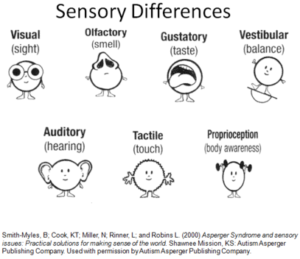
Sensory Sensation

Date Published: October 26, 2022
Author: Jessica Mattox, RBT
Every day our senses work together in ways we might not even notice. Our senses are essential to help us understand the world we live in!
Sensory processing refers to the way our brain receives messages from receptors and interprets, organizes, and processes them to create motor and behavioral responses. Examples include: smelling to help us taste food, feeling a hot coffee mug and then blowing to cool it, and dancing while listening to music! The combination of our senses plays a role in self-regulation, self-protection, fine motor skills, balance, and more.
The five most commonly discussed senses are vision, smell, hearing, taste, and touch. There are three more senses called vestibular, proprioceptive, and interoceptive. The vestibular system located within the inner ear provides information about motions and our head and body position. This sense is responsible for balance and posture. The proprioceptive sense is guided by receptors in our joints and muscles, which gives us awareness of where our body parts are, how much force we apply, and how we synchronize our body movements. Lastly, the interoceptive sense provides information from our internal sensations. With this sense, we recognize hunger cues, manage needs, and regulate emotions. We are constantly processing information from multiple senses!
Individuals with sensory processing difficulties may experience a range of hypersensitivities (over-responsiveness) and/or hyposensitivities (under-responsiveness). Hypersensitivity may result in individuals avoiding a sensation because the sensory input is overwhelming. Observable behaviors may appear as; a refusal to wear scratchy clothing, inability to tolerate loud noises or bright lights, or avoidance of physical touch. Hyposensitivity may result in individuals seeking more sensory input because the input is soothing or stimulating. Observable behaviors may appear as; enjoying fast spinning, stimming, fidgeting, or chewing clothing/objects.
Overstimulation or sensory overload occurs when an acute sensation or multiple sensations build up over time. Sensory overload can engulf an individual and make managing other functions difficult. For example, an individual sitting still under bright lights while listening to loud singing may become fatigued and feel a need to escape or cover their ears.
There are many safe and fun activities that support a combination of sensory experiences. Sensory bins provide a wide variety of options for tactile play! You can use water beads, sand, beans, and even slime! For vestibular input, jumping, swinging, gentle roughhousing, and balance beams all encourage individuals to feel their movements. Proprioceptive activities include using pretend hammers and nails, crash pads, or carrying weighted balls. Playing catch, watering plants, and creating visual schedules integrate the visual sense and also provide input from other senses! Auditory activities like playing the xylophone practice fine motor skills and listening skills. Engage your nose by guessing spices or coloring with scented markers. With any activity, be mindful of overstimulation and provide breaks as needed! These are just a few of the countless activities that combine and engage multiple senses. Resources such as occupational therapy, speech therapy, feeding therapy, and ABA can teach us more about supporting individuals with sensory sensitivities. Collaboration is key!
About the Author:
Jessica Mattox is a Registered Behavior Technician (RBT) on the Faces Behavioral Services team. Faces Behavioral Services is a department of the Pacific Autism Center for Education that supports children with autism in reaching their full potential utilizing Applied Behavior Analysis (ABA).
Disclaimer: “Keeping Up the PACE” is a blog operated by Pacific Autism Center for Education with information provided by professional therapists. This content is not intended for the purpose of diagnosis of any condition. If you have a question for our team, please email us at email hidden; JavaScript is required.


